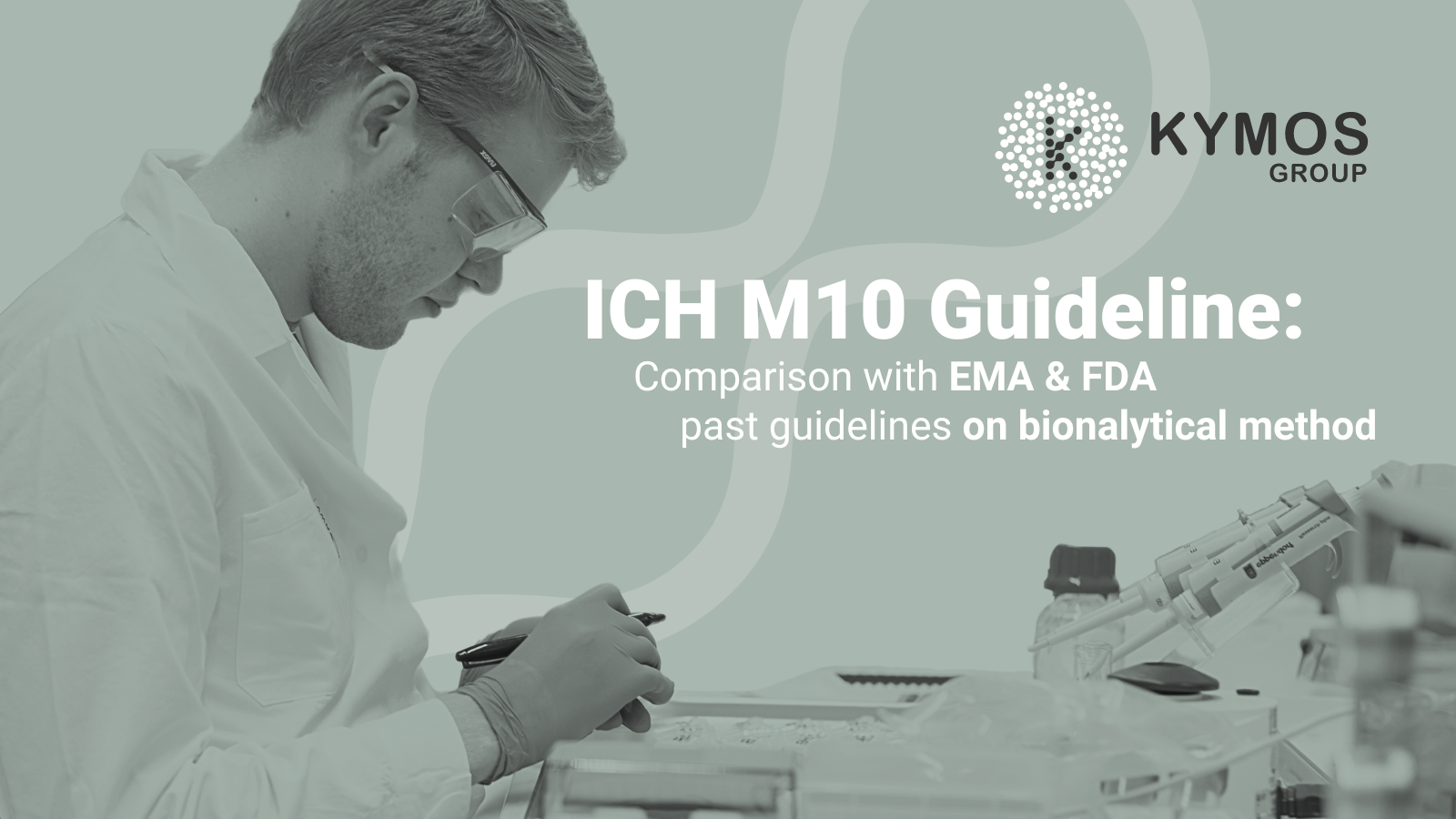
Although the ICH has published recommendations for the validation of analytical methods used in the evaluation of the quality of drugs and active substances (ICH Q2) for more than 25 years, it was not until recently (2022-2023) that we got a harmonized guideline that comprehends validation and analysis of drugs and analytes in biological matrices.
These matrices, unlike what we can find in medicines or finished pharmaceutical products, present a very high complexity and also extraordinary individual or inter-individual variability. For this reason, ICH M10 is a very important harmonizing effort that has been adopted and implemented by the FDA and the EMA already and is in the process of implementation by other regulatory organizations and administrations.
Taking that into consideration, our Bioanalytical departments working together with our Quality Assurance Unit have summarized and synthesized the main key points and differences from the old guidance that are impacting the most in bioanalytical studies.
Introduction and Scope
ICH M10 describes the bioanalytical method validation that is expected to support regulatory decisions, and in doing so, it has a specific scope to which these guidelines apply. These studies are:
- Nonclinical toxicokinetic (TK) studies and pharmacokinetic (PK) studies conducted as subrogate for clinical studies
- All phases of clinical trials in regulatory submissions (including comparative bioavailability/bioequivalence (BA/BE) studies).
- In general, studies subjected to GLP or GCP
Biomarkers are out of scope unless they are the main endpoint of the study. The biological matrices include blood, serum, plasma, and other body fluids or tissues.
General Principles
Method Development
Regarding method development, the new ICH M10 takes most from the past FDA guidelines. Method development should define the design, operating conditions, limitations, and suitability of the method for its intended purpose and to ensure that it is ready for validation.
Full validation
ICH M10 further expands on previous guides by EMA and FDA about when a full validation of a bioanalytical method is needed.
Chromatography Assays
Validation
The ICH M10 provides additional details and guidelines for every element in the method validation of chromatography assays and expands and even create new chapters for some of them in the new guide. Our team has summarized the key parts and differences from EMA/FDA past guidelines:
- Selectivity has been separated from specificity in the new ICH M10
- Matrix effect (ME): In relation to matrix effect, the ICH M10 gives more precise guidance than past EMA and FDA, advising the determination of accuracy and precision for each individual matrix source/lots evaluated
- Regarding A&P the ICH M10 expands the base from EMA and FDA and combines some of their recommendations. The most important one, the calibration curves for these assessments should be prepared using freshly spiked calibration standards in at least one run. If freshly spiked calibration standards are not used in the other runs, the stability of the frozen calibration standards should be demonstrated.
- Stability: ICH M10 further elaborates what we had in EMA/FDA past guidelines and specifies recommendations for stability of the analyte in biological matrices, in processed samples, and in stock and working solutions.
Study Sample Analysis
ICH M10 determines that the analysis of study samples can be carried out after validation has been completed (by this time the data are submitted to a regulatory authority), but it is understood that some parameters may be completed at a later stage. ICH M10 remains mostly the same in the parameters and procedures, with minor changes and some little additions.
Ligand Binding Assays
Key Reagents
Our team has summarized the key parts and differences from EMA/FDA past guidelines regarding key reagents for ligand binding assays:
- Reference standard: As in EMA/FDA, ICH M10 doesn’t require primary standards. The same information and recommendations as in past guidelines regarding CoA and reference standard expiration, usage of the same batch for the calibration curve, and changes of batches.
- Critical reagents: The recommendations are based on EMA/FDA, but it is important to note that stability testing of these critical reagents should be based upon the performance in the bioanalytical assay and be based upon general guidance for reagent storage conditions and can be extended beyond the expiry date from the supplier.
Validation
- Specificity: ICH M10 maintains the same recommendations that EMA/FDA had regarding the procedure and acceptance criteria of specificity, but it notes that if there is cross-reactivity, the impact must be evaluated.
- Selectivity: ICH M10 states that matrix can contain non-specific matrix components which may interfere with the analyte of interest. Some of the expanded recommendations from the past are selectivity at the low end of the assay, spike levels, and minimum number of patients in the case of relevant populations. Same acceptance criteria.
- Calibration curve and range: Regarding calibration curve and range, ICH M10 remains mostly the same as past guides, but it also states that it should be preferably prepared using freshly spiked calibration standards. Same acceptance criteria, except for minor expanded points
- Accuracy and precision: The main difference in these parameters is that in ICH M10, it is recommended that the QCs should be prepared by spiking matrix, and stored under the conditions anticipated for study samples. It also adds a new concentration level for QCs preparation (mid, around the geometric mean), and it also recommends that accuracy and precision should be evaluated using the same runs and data. Acceptance criteria are based on EMA and FDA.
- Dilution linearity and hook effect: We can find the same recommendations as in EMA/FDA (harmonization of both), with minor additions. On acceptance criteria, ICH M10 recommends that the dilution factor(s) applied during study sample analysis should be within the range of the dilution factors evaluated during validation.
- Stability: ICH M10 states that stability should cover the processing and storage conditions, and stability samples should cover the whole range of concentrations of the study samples. For biological drugs, the new guideline adds that it is acceptable to apply a bracketing approach (in between temperatures of two points), and regarding procedure and acceptance criteria the recommendations are the same harmonized.
Study Sample Analysis
- Analytical run: The run composition and placing of the QCs in the run is the same as in EMA/FDA, and when analyzing more than one plate, each plate should contain an individual set of calibration standards and QCs.
One key point in ICH M10 is that the QCs should cover the expected study sample concentration range. It is also noted that it is allowed to do single well analysis (validation and study samples both).
Regarding to calibration curve and acceptance criteria the ICH M10 is a harmonization of both EMA and FDA, and Overall mean accuracy and precision of QCs of all accepted runs should be calculated at each concentration level and reported in the analytical report.
- Reanalysis of Study Samples: For the reasons, criteria, and number of samples for reanalysis the recommendations are the same as in EMA/FDA. The ICH M10 states that the analysis of the samples should be based on the same number of wells per study sample as in the initial analysis.
Incurred Sample Reanalysis (ISR)
As per ICH M10, ISR is intended to verify the reliability of the reported sample analyte concentrations and should be performed in the situations that were specified in both EMA and FDA and are now combined and harmonized in the new guideline. The studies, numbers, sample selections and the calculation are unchanged.
Conclusions
As seen in this summarized text, ICH M10 presents a harmonized framework for bioanalytical studies that is already implemented by the FDA and the EMA and has become the standard when analyzing drugs and analytes in biological matrices.
Since our adaptation to this new guideline, we have received very positive feedback from our clients about this new version of validation protocols and sample analysis protocols, confirming the compliance of our methods and procedures with ICH M10.
If you need more information about this new guideline or any assistance with your projects, please contact quotes@kymos.com. We will be pleased to provide you with detailed consulting and support.

